Osprey Research - Overview
Introduction
My studies of Ospreys focus on long-term monitoring of the Martha's Vineyard population and radio-tracking both adult and juveniles tagged at various locations from the Chesapeake Bay to northern New Hampshire. The Vineyard population now numbers well over 80 pairs, including breeders and "housekeepers" and and has been very slowly growing for the past 15 years. My telemetry work relies on satellite telemetry mostly (but now we're using cell-tower transmitters as well) to track the movements of mostly males around their nests as they hunt for fish to feed their families and the migration of both juvenile and adults as they move back and forth between their winter homes (mostly in South America) and their breeding territories somewhere in the mid-Atlantic to New England regions of the U.S. I will expand our study area to Newfoundland in August of 2016.
Censuses
In 1971, when I began studying birds of prey on Martha's Vineyard, there were two pairs of Ospreys on the Island. By 1992, thanks to the efforts of Gus Ben David, then director of Mass Audubon's Felix Neck Wildlife Sanctuary, and a large number of Osprey devotees working under his guidance, the population had increased to over 70 pairs. In the early to mid-70s, largely as a result of the indiscriminant use of DDT, Ospreys nationwide suffered a significant decline in their populations. After the national ban on DDT use in 1972, they have since fully recovered and in some places far surpassed pre-DDT population levels.
Gus monitored the Vineyard population through the '94 season. I picked up the census again in 1998 and, with the help of some graduate students and a number of Island residents, have monitored the number of breeding pairs and the number of young fledged each year. Dick Jennings joined the team in 2005 and has done the lion's share of the census work since then.
In 2015 we began a program using volunteer nest monitors to take some of the burden off of Dick's shoulders. When he started running the survey there were 56 breeding pairs and it was sort of manageable for one person to keep track of what was going on during the breeding season. Now it is not!
Satellite Telemetry
In 2000 I began collaborating with Mark Martell on his studies of Osprey migration. A small (and rather expensive) transmitter attached to an Osprey's back enables us to track a bird daily as it migrates. We tagged two Ospreys in 2000, and since then have deployed transmitters on 84 more. Twenty-nine of these were tagged on Martha's Vineyard and the rest between South Carolina and northern New Hampshire.
The next year I tagged three adults on the Vineyard and an adult female near my home in Charlotte, NC.
In 2004 I helped the BBC on the Osprey episode of their documentary series, Incredible Journeys. We tagged five new birds that year--two adults and three young of the year. These were the first young Ospreys we tagged. Spurred on by our success with tagging young birds in '04, I decided to focus all my attention on satellite tagging young birds. That year we tagged two young--one on the Vineyard and one in Rhode Island. I have tagged 42 young since those first BBC stars back in 2004.
In 2006 we tagged three recent fledglings in Delaware in or around Cape Henlopen State Park, one in Rhode Island, and a single bird on the Vineyard. One or the young birds tagged for the BBC, Jaws, returned to the Vineyard for the first time.
In 2007 we tagged five young birds again--two in Delaware and three on Martha's Vineyard. Jaws, from the class of '04 returned for his second trip home, and Homer, tagged near Little Homers Pond on the Vineyard, returned for the first time. This was the first year we used GPS-enabled transmitters, which opened up a whole new world of research possibilities. The previous transmitters were accurate enough to follow migration, but not to follow the daily hunting movements of individual Ospreys.
In 2008 we tagged seven young Ospreys--one in South Carolina, one in Delaware, two on Cape Cod, and three on Martha's Vineyard.
In 2009 we initiated studies of adult hunting behavior by tagging four adult males--three on the Westport River, just west of New Bedford, MA, and one on Nantucket Island. That summer we tagged seven juveniles-five on Martha's Vineyard, one on the Westport River, and one in South Carolina.
Seven birds were tagged in 2010. We tagged adult males in Rhode Island (2), the Westport River in SE Massachusetts (2), and Nantucket Island (1). Two young were tagged on Martha's Vineyard that summer.
In 2011 we tagged two adult males on Martha's Vineyard in the spring, two juveniles on the Vineyard, and two in New Hampshire. The latter were the northernmost birds I've tagged and the first birds in a cooperative program with the Squam Lakes Natural Sciences Center funded by PSNH (Public Services of New Hampshire).
New technology became available in 2012. We tagged two adult males on the Westport River with "GSM" transmitters, which download their data via cell towers, rather than satellites. This enables us to get GPS locations sometimes minute-by-minute, rather than once an hour, and thus provides a remarkably detailed description of how our birds are using their environment. In addition to the two GSM-tagged males, we satellite-tagged an adult male on Long Island and one in New Hampshire, as well as two more New Hampshire juveniles.
2013 was a banner year (despite my repeated claims that I was going to slow down my tagging efforts). We tagged seven adult males with GSM transmitters (four on Chesapeake Bay, one on Fishers Island, and two on Martha's Vineyard), and four adult males with satellite tags (two adult males in Washington, DC, and two males in New Hampshire). One of the New Hampshire nests is about 20 miles from the Canadian border. In the summer we satellite-tagged one young on Long Island, two on Martha's Vineyard, two in coastal Massachusetts north of Boston, one on the New Hampshire coast, and two in New Hampshire's Lakes Region. At the latter nest, we retrapped the adult male (Art), whom we had tagged the year before, and moved his transmitter to one of his young.
2014 saw my efforts to slow down sort of take effect. We only tagged 11 birds--6 adults and 5 juveniles. The adults included two birds on the Chesapeake (Chester and Crabby), three at the mouth of the Connectict River (Gerry, Roger Tory, and Uncas), and one (Charlie) on Fishers Island at the mouth of Long Island Sound. Details on the 2014 Bios Page.
In 2015 we only tagged five birds--all in New Hampshire. In the spring we tagged three adult males: Wausau, Gundersen, and Staddler in the North Country, Lakes District, and Coast, respectively. In early August we tagged two juveniles (Juliet and Lizzie) at two of our old faithful nests in Tilton and Bridgewater. Details on the 2015 Bios Page.
2016 will be our last year to initiate new studies. We will continue to help the Chesapeake Bay Foundation by tagging a few birds for their educational program as long as they want, and will redeploy a transmitter on a young bird in DC this summer, but that's pretty much it going forward. The big plan for 2016 is to tag up to 6 Ospreys (ideally 4 juveniles and 2 adults) on Newfoundland's Avalon Peninsula. The peninsua, is the easternmost part of the Osprey's North American breeding range and sticks way out in the Atlantic Ocean. What will the young Ospreys on their first migration do? Based on what we've seen from Matha's Vineyard juveniles, it is likely that some young from Newfoundland will head south over the Atlantic and may make the longest overwater crossing of any raptor in the world. Stay tuned! Details of this year's birds on the 2016 Bios Page.
2017 was a dismal one for our birds. We started the year with 11 birds "on the air" and tagged five new young, four in two trips to Newfoundland and one in DC, redeploying a transmitter that spent six months on the bottom of the Potomac. Details: Wausau (NH), Belle (Cape Cod and Martha's Vineyard), Nick (Chesapeake), and Aster (Newfoundland) had their radios fail. We know Belle and Wausau are OK, assume Nick is, and saw Aster around her nest with the dead radio, so she at least survived a while. Additionally, Snowy, a male from Martha's Vineyard was spotted again at a nest in Nantucket. Three birds were lost on the breeding grounds (Daphne and Da Rock [NFLD] and Hackett [Chesapeake], one on the wintering grounds (Leif [NFLD]) just after the new year, and five heading south (Shana and Tommy Rickets [NFLD], Staddler [NH], Flow [MA], and Layla [DC]). We finished the year with one bird (Borealis) surviving, and one (Holly) hopefully alive and just not near a cell tower.
2018 brought good news in March, when Holly showed up in Jamaica on her way north, and sad news when Borealis went off the air suddenly in the middle of August. No new birds were tagged and I let my permits expire, so now I really can't tag any more birds. Surprisingly, Holly did not return to her nest, where her mate Hackett died mysteriously last summer. She never seemed to focus on one spot, so it seems she did not find an attractive bachelor male. With as many as 10,000 pairs of Ospreys in the Chesapeake Bay area, it seems there aren't that many vacancies on the real estate market.
2019 began with our having no idea whether we still had a bird on the air or not, as Holly hadn't been near a cell tower since the fall of 2018! To our delight, she passed by a cell tower in late January, obviously already winging her way home.
---------------------------------------------------------------------------------------------------------------
The 2016 spring migration
At the end of the winter we were following eight birds--7 adults and one young finishing his "gap year" down in Cuba.
Like last year, Edwin was the first to leave his winter waters. He left the Amazon River on 27 Feb and got back to Connecticut on 23 March. Edwin was tagged at his nest on Fishers Island in eastern Long Island Sound in 2013. His nest failed that year and he did not return to it in 2014. In 2014 and '15, Edwin was all over southern Connecticut with frequent visits to Gardiners Island, where we hoped he would nest.
Belle left her/his (see below) winter range down on the Madeira River at the southern edge of the Amazonian rainforest on the 4th of March. He made the long (ca. 4,500 miles) trip north with no stops--all business. But when he arrived on the Cape, there was no indication of any sort of househunting. Other bachelor birds have spent a lot more time obviously scouting out nest platforms.
On 12 March, eight days after Belle took off, Snowy left his winter HQ in Cuba and made a mad dash back to the Cape and Islands arriving in his corner of southern New England just eight days after he packed his bags and started north. More on Snowy's spring arrival below.
Next off the starting blocks, on 18 March, were Wausau and Nick. Nick took 13 days to get from the Magdalena River valley in northern Colombia to Tangier Island in the southern reaches of Chesapeake Bay. Once there, he apparently didn't find enough fish, so he crossed the bay and spent a week or so cruising around Virginia. He's since shifted back to Tangier, where he's now spending almost all his time. Wausau moved about 150 miles north from his winter waters in central Colombia and then turned around and went back to his wintering area on the 23rd. Rumor has it that he forgot his passport. That's as good a reason as we can come up with, so we're sticking with it. After tending to whatever loose ends he had left around the winter home, he took off again on the 28th and arrived at his nest in northern New Hampshire on 18 April. Thanks to his delay, when he got home, his mate had paired up with a new male. Wausau chased the intruder away and is now settled in at the nest. See more details of Wausau's travels on the Squam Lakes Natural Science Center website.
Staddler was next to head north, leaving on 19 March and arriving in coastal New Hampshire on 6 April. He was definitely a bird on a mission. He's now settled down at his nest on the Hampton Beach marshes. Details at the Squam Lakes Natural Science Center website.
Quin, who had been off our radar screens in Cuba all winter, reappeared when he got to Florida. He left his winter range on 23 March. His cell-tower transmitter failed when he was in Georgia, leading us to suspect the worst. Lo and behold, he was spotted at his nest on Tangier Island sometime in late March or early April, so we know he's OK but his transmitter isn't.
Finally, Flow, an almost-2-yr old male tagged in Essex Co., MA, was the last to get moving north. He's pretty much a teenager, so a late start is to be expected. This is his first trip north after 18 months in Cuba. He began the trip on 27 April. We've had only one young start later (8 May). He's now (6 May) in Virginia. It will be interesting to see if he spends time at a few locations around Delaware and Chesapeake Bays where he lingered for quite a while on his trip south back in 2014.
---------------------------------------------------------------------------------------------------------------
Early September 2014 Update
Follow our birds on your smart phone!
This was in the last update, but I'm leaving it in for the benefit of new subscribers and those who didn't open the last update.
Our colleagues at Movebank have developed a mobile App for iPhones and Android devices. It's called "Animal Tracker" and is free. Launch the App and click on the North American points--all but two (Great Blue Herons tagged by John Brzorad in North Carolina--are our Ospreys. Click on one of the icons and you'll see a screen like the one below. There's a brief bio of the bird and if you click on the 2-week or 1-year movement data, you'll see an animation of the bird's movement in that time period. You can also add observations of tagged animals if you track one down using the App.
Way cool!
An early start to the fall migration
By just one day, this isn't the earliest start for our tagged birds, but we've never had this many moving south in late August.
Snowy was the first to head south--just a day later than she left last year. We had been calling Snowy a male, but after another August departure (typical of adult females, not males) I had a look at the banding data and saw the weight was awfully high for a young male and fairly typical for a fledgling male, so Snowy's a "she." Glad we picked an sexually ambiguous name.
Snowy was a bird on a mission. She arrived back at her wintering area in northern Cuba just eight days after she left her staging area in Long Island.
The interesting thing about Snowy is that on her first migration, back in 2011, she made it to Venezuela and spent her 18-month "gap year" on the Venezuelan llanos. On her first trip north in the spring of 2013, she stopped at a big marshy area in northern Cuba and spent a month there before finishing her spring migration back to Martha's Vineyard. On her 2nd trip south, instead of going back to Venezuela, she found her way back to the Cuban refueling stop and spent the winter there. This seems to be her spot. She would probably sit there watching all the Ospreys going by heading to the treacherous Caribbean crossing with a smug smile on her face--if she could smile.
Flow started migrating on the 20th, only nine days after we tagged him at his nest in Essex, MA. Four days later he was at Cape May, NJ, where he spent two days before heading northwest to the Newark, DE, area (just 30 miles west of "Map Central" here in the Philly 'burbs). I suspect he's been spotted at least once by the counters at the Cape May hawk watch.
Next to take off, on 18 Aug, was Edwin, our dilettante male Osprey from Fishers Island. This spring Edwin did not return to nest on Fishers, where we tagged him in the spring of 2013, but spent the summer wandering around Connecticut and eastern Long Island. He got to southern Florida on the 24th and then dropped off the map. He has a cell-tower transmitter, so we didn't hear from him again until he got to Haiti. Then he found a couple of cell-towers down in Venezuela, and we last heard from him on 1 Sept, after he had crossed the Gulf of Venezuela. That's an unusual route. Most of our birds go around the Gulf, rather than across it.
He is heading back to his wintering grounds on the banks of the Amazon River, deep in Brazil. We may hear from him again over the winter, but last year we did not, so it may be only in the spring that we get a signal from him again. He's made it through the tricky part (crossing the Caribbean), so chances are we'll see him next spring, if we don't hear from him in the meantime.
The fourth bird off the starting blocks was Tilton, a youngster from central New Hampshire. He started south on the 19th and spent the night on the CT/MA border at Colebrook River Lake. The next day he spent a few hours fishing at Highland and Burr lakes in central CT. The next night was spent at Croton Falls Reservoir in Putnam County, NY and the following day he fished along the east bank of the Hudson River, spending the night in Ossining. On the 22nd, he was in Cape May, NJ, where he's been ever since. It's not unusual for young birds to have some false starts to their migrations. In fact, sometimes it's hard to tell exactly when a bird really started migrating or was just "exploring" the countryside around their nests.
Around 9AM on Aug 20th, a day after Tilton headed south, another newly tagged New Hampshire juvenile, Bridget, left home on the first leg of her first migration. At 2PM she was on the Connecticut River in Massachusetts. She worked her way down the river a bit and spent her first night away from home in Brattleboro, MA. On the 21st, she left the river and moved south only to find it again, about 30 miles downriver in Sunderland, CT. After spending the night there, she moved south again and found the Housatonic River, just 5 miles north of its mouth on the north shore of Long Island Sound. As of 2 Sept, she's still there, waiting for the mood and the weather to nudge her into motion again.
And now it gets really weird! Ron, our adult male from the Anacostia River in Washington, DC started his second migration wearing one of our transmitters on 24 Aug. He moved quickly down the coast to Florida. On the 26th, he started the day's migration around 9:30 and headed over the Florida Straits toward Cuba around 4:30PM. He should have reached Cuba about 4 hours later. Instead, 8 hours later we have a location in the middle of the Strait and then 6 hours later he was just 80 miles west of the midnight location, still out over the water.
He must have landed on a boat sometime in the late afternoon of the 26th, ridden on it for a while, and then bailed out when he saw the Keys. That makes sense. He might have run into bad weather. But what happened next is totally baffling. He turned around and headed north, retracing his path up the east coast all the way to Virginia. On the 3rd of September, he was 120 miles south of his home range. As of the 4th, he's back in DC! Besides the obvious joke that he must have forgotten his passport, there's really no explanation that makes sense here.
Next to start migrating was Crabby, who seems to be doing things the normal way. Crabby is an unmated, presumably young (maybe 3 yrs old) female from Kent Island in Chesapeake Bay. She started south on Aug 25 at 10:55AM. She spent her first night at Kerr Lake on the VA/NC border. Lots of our birds have stopped here. Next stop was the Congaree Swamp just north of Lake Marion in South Carolina. She blew through Georgia and spent the night of the 28th in northern Florida and made it to the Everglades in southern Florida on the 29th and spent the night there. That was the last we've heard from her, but this is pretty typical of our cell-tower birds. From here on, they can make it to South America without being near a cell tower (the only way we hear from them). We've had birds that we last heard from on the eastern coast of the U.S. in the fall only to have them show up again the next spring. But, we've also had a remarkable number of cell-tower birds find cell towers in Haiti and down deep in South America.
Uncas, an adult male tagged this spring at the mouth of the Connecticut River, faked us out with a move down the coast on the 29th. After spending the night in Milford, just west of New Haven, he surprised us by heading northeast back inland and looping back to his home in Old Lyme. Very strange.
On the 3 Sept he took off again, and it looks like this time he means it! At 9:45 or so, he headed out over Long Island Sound. It looked like just another fishing trip, but this time, after a strange zig due west, he turned south and crossed Long Island Sound. He got to Long Island at 10:26 and wandered south. He flew right over the nest where we tagged Pearl last year and Clyde this year. It took him 5 and a half hours to cross Long Island heading west. He crossed over to Sandy Hook in New Jersey where he last checked in at 5:37PM. -- Last minute update: as of the 4th, he is in Pennsylvania, west of Philadelphia.
A mysterious loss
Chester, an adult male tagged this spring at his nest on Kent Island in northern Chesapeake Bay, died on July 29th. That morning he was perched in some trees near his nest and then the signal moved to a stand of reeds at the edge of his cove, just a few hundred meters away. That was the last movement recorded. Armed with the GPS coordinates, Rich Harrison as able to locate the transmitter and not much more than some Osprey feathers.
We can't blame this one on Great-horned Owls, shooting, or a collision, and are really at a loss to explain what happened. The only good news is that Chester and his mate fledged two young, we got the transmitter back, and we got lots of foraging data from him.
Meanwhile, down in the Amazon...
Our surviving juvenile from 2013, Artoo, is peacefully fishing away down in Brazil. He's about 300 miles west of Manaus. He should be there for another 7 months or so. He has probably already seen the first adult females returning to their wintering grounds.
An all-Osprey issue of the Journal of Raptor Research
This December's issue of the Journal of Raptor Research will be devoted to Ospreys. Alan Poole, Brian Washburn, and I have been editing a collection of papers written by Osprey researchers from Australia, Europe, and both South and North America (including Cuba). Of particular interest to our group will be a paper on the history of the post-DDT recovery of the Osprey population in southern New England and several papers on Osprey migration.
I was delighted to hear that the last paper had been sent off to the printer on Friday.
1,000+ subscribers!
Last week Mail Chimp (the website I use to put these updates together) informed me that our e-mail list passed 1,000 subscribers. It's very rewarding to know that besides learning so much about Ospreys, we're sharing that knowledge with such a large group of Osprey followers. So, please keep passing the newsletters on to folks you think would be--or should be--interested in Ospreys and their environment.
----------------------------------------------------------------------
Mid June 2014 Update
(Scroll up for other updates and links to more on the OspreyTrax site.)
Foiled in New Hampshire
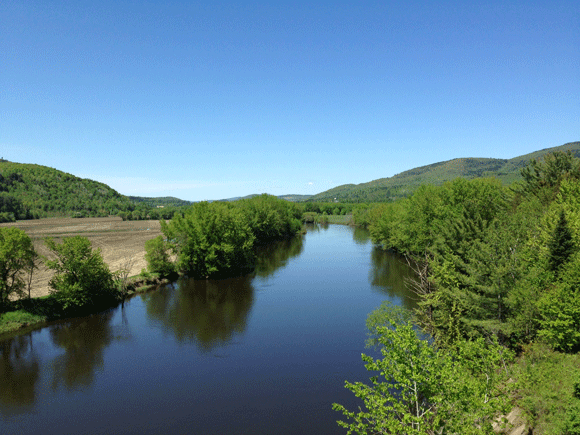
After my successful trip to the upper Chesapeake Bay, in late May I headed north for another round of trapping. And I do mean north. On the 29th of May, along with Iain MacLeod, my partner in the study of the inland-nesting Ospreys of New Hampshire, I headed to the upper reaches of the Connecticut River, just 20 miles south of the Canadian border. We planned to trap the male that replaced Mackenzie, the unfortunate adult male we tagged last year. Mackenzie was killed by a Goshawk or a Great-horned Owl before he could start his migration.
The image above, taken from our target nest shows the Connecticut River, with New Hampshire on the right and Vermont on the left.
We did trap the female and confirmed that she's the same bird we trapped at this nest in 2012 in an unsuccessful attempt to tag her mate.
In 2013 we were able to trap the male (Mackenzie) at this nest, but this year we were once again frustrated here as we tried to tag Mackenzie's replacement. We caught the female in just a few minutes, replaced her three eggs with wooden dummies so there wouldn't be any problems with the eggs chilling, and waited for the male to move in and do his paternal thing.
Nothing doing. He was just not interested. We do occasionally encounter males with very little inclination to engage in the care of eggs. This might be a young male in his first breeding attempt who just hasn't figured it all out, yet. So, after it became clear that we were not going to catch our target bird, we removed the trap from the nest, swapped the real eggs for the dummies, moved everything away from the nest, and released the female. She was back on the nest in very short order.
At the other end of the Connecticut River
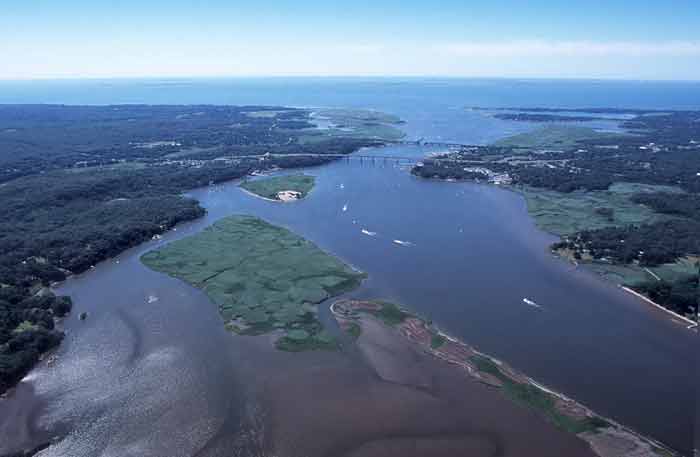 240 miles south, the Connecticut River looks a little different. This aerial view (not from a nest!) shows the wide expanse at the river's mouth where it opens to Long Island Sound.
240 miles south, the Connecticut River looks a little different. This aerial view (not from a nest!) shows the wide expanse at the river's mouth where it opens to Long Island Sound.
This is Osprey Mecca. In the pre-DDT era (before WWII) the 200 pairs nesting in this area formed one of the three major colonies in southern New England and Long Island. Many pairs nested on the marshy islands, like the one on the left in this aerial, either right on the ground or on the roots of trees that floated down the river and landed on the islands.
In the 1950s and 60s, as DDT worked its way up aquatic food chains, Osprey populations crashed. In this colony, the alarming decline occurred under the watchful eyes of Roger Tory Peterson, who sounded the alarm.
At first we didn't know why reproduction was so poor--was it something to do with the eggs, or could the parents not raise young that hatched? Peterson, along with Gerry Mersereau (more on Gerry below) and Peter Ames, thought the problem might have been predation on ground-nesting birds or flooding at spring tides, so they erected nesting platforms. The Ospreys quickly took to the platforms, but this didn't help them fledge more young.
Paul Spitzer then definitively answered the question by reciprocally swapping Maryland eggs (some Maryland Ospreys were doing much better than Connecticut birds) with Connecticut eggs. His work showed that the problem was in the eggs, not the parents' ability to feed young. Maryland adults couldn't hatch Connecticut eggs, while Connecticut adults did fine with Maryland eggs. That was part of the process that led to fingering DDT as the main culprit in the collapse of the population.
Four decades later, I set up my spotting scope on Griswold Point, right at the mouth of the river and scanned the Point, Great Island, and adjacent Smith Neck. When I had finished the scan I had counted a remarkable 56 Ospreys and about 30 nests. And those were just the birds that were incubating eggs or perched near their nests. The whole time I was counting, Ospreys were coming into the colony with menhaden--probably their favorite fish--or heading out to hunt.
As I watched all those Ospreys, I thought about how depressing it must have been to study this colony in the early 70s, when over a three-year period about 25 pairs were unable to fledge a single young.
How different it is now! The population is growing, all the platforms seem to be occupied, birds without a nest platform are nesting on the ground, and some are "going retro"--nesting in trees!
Connecticut River Tagging
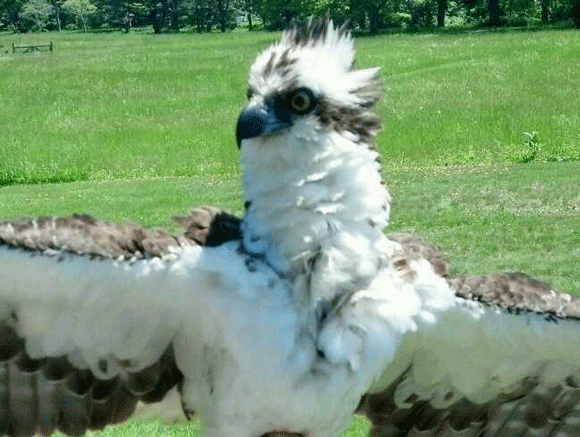 I arrived in Old Lyme, at the mouth of the Connecticut River on May 31st to work with Paul Spitzer, who is back in his natal territory to survey the Connecticut River colony 40 years after his seminal studies of the Long Island Sound Ospreys in the dark days of the DDT decline.
On June 1st we set out to put cell-tower transmitters on two adult males. All went perfectly. At our first nest, on Griswold Point, we quickly (maybe 4 minutes after setting the trap) caught the female, and then got the male just a few minutes later. The male was already banded. We named him "Gerry," in honor of Gerry Mersereau (mentioned above) who banded Ospreys from the 1960s through 2005 when he passed away. It came as no surprise when we found out that our "Gerry" had indeed been banded by Gerry Mersereau on 23 June 1998. (See Gerry's maps.)
I arrived in Old Lyme, at the mouth of the Connecticut River on May 31st to work with Paul Spitzer, who is back in his natal territory to survey the Connecticut River colony 40 years after his seminal studies of the Long Island Sound Ospreys in the dark days of the DDT decline.
On June 1st we set out to put cell-tower transmitters on two adult males. All went perfectly. At our first nest, on Griswold Point, we quickly (maybe 4 minutes after setting the trap) caught the female, and then got the male just a few minutes later. The male was already banded. We named him "Gerry," in honor of Gerry Mersereau (mentioned above) who banded Ospreys from the 1960s through 2005 when he passed away. It came as no surprise when we found out that our "Gerry" had indeed been banded by Gerry Mersereau on 23 June 1998. (See Gerry's maps.)
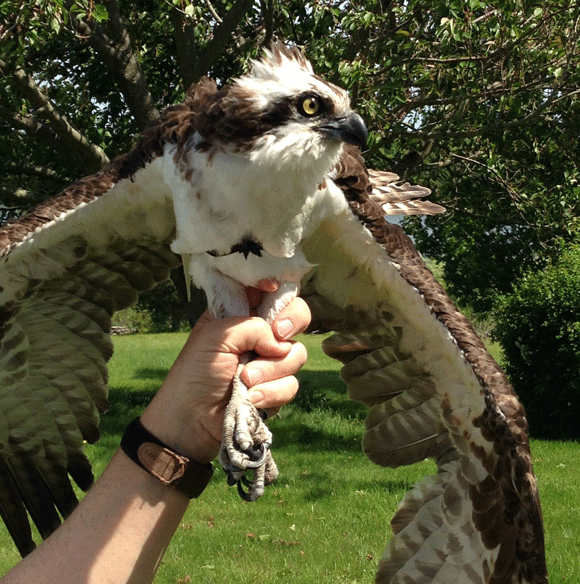
After lunch, we set our trap at a nest on Smith Neck. Once again, we quickly caught both the female and male. Both were banded! The male's band looked old, and indeed it was. He was banded by Mersereau in June of 1997, so he is 17 years old. The female is a relative youngster. She was banded 8 years ago by personnel of the CT Dept. of Environmental Protection. We named the male here "Roger Tory" for obvious reasons. (Follow Roger's maps.)
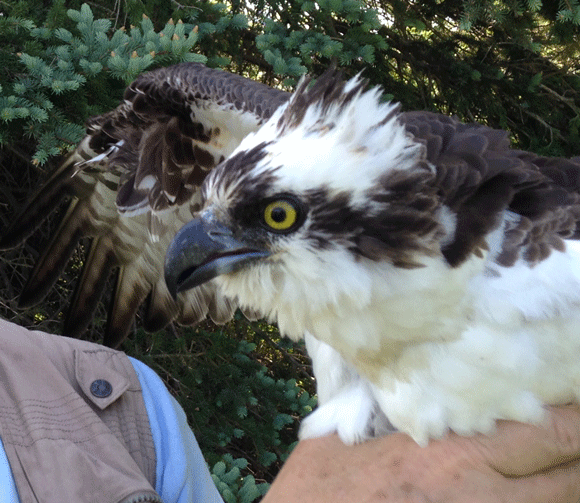 On June 2nd we were out trapping again, this time at a nest less than 150 meters from Roger Tory's nest. Once again, trapping went perfectly. The whole process, from setting the trap to tagging and releasing the male, took only 51 minutes. We named this male "Uncas." Uncas was a sachem (chief) of the Mohegan tribe in lower Connecticut. (See Uncas' maps.)
On June 2nd we were out trapping again, this time at a nest less than 150 meters from Roger Tory's nest. Once again, trapping went perfectly. The whole process, from setting the trap to tagging and releasing the male, took only 51 minutes. We named this male "Uncas." Uncas was a sachem (chief) of the Mohegan tribe in lower Connecticut. (See Uncas' maps.)
Chesapeake Bay Update
Not much news from Chesapeake Bay. Down on Tangiers Island, based on the results from their transmitters, Nick did not nest, and Quin seems to be feeding young. I'm still waiting for confirmation from the ground.
Further up the Bay near Annapolis, all seems well with Woody, who nests near the Annapolis side of the Bay Bridge. Across the bridge, on Kent Island my eyes on the ground report that Chester is now the proud father of three chicks. (Follow Chester's maps.)
Our most interesting bird on the Bay is the newly tagged Crabby. Crabby was "by-catch," if you will, of our trapping attempt at a nest on Cox Neck (near Chester's nest). We couldn't catch our target bird--the male at the nest--but did catch a hanger-on female and decided to tag her. She's obviously a relatively young bird that does not have a nest yet.
Not having a nest, Crabby is free to wander around. Right after we caught her, she started commuting between Cox Neck and Tuckahoe State Park where she fished Tuckahoe Creek. She made 5 trips from Kent Island, where we caught her, to Tuckahoe Creek. Jim Uphoff, a fisheries biologist with Maryland's Dept. of Natural Resources, reports that Alewife, Blueback Herring, Hickory Shad, Gizzard Shad, as well as Yellow and White Perch run up Tuckahoe Creek. All of those are favorite Osprey chow. (Follow Crabby's maps.)
In DC, our two satellite tagged birds, Ron and Rodney, seem to be fine, although neither nested this year.
New England Update
Our first addition to the New England flock, Charlie, was feeding three young at his nest on Fishers Island. His movements have been quite surprising (follow his maps).
The two surviving New England cell-tower birds from last year are doing well, although Edwin (Fishers Island) did not nest this year. He has been wandering all over eastern Connecticut and even down to Gardiners Island.
DJ, a male from Martha's Vineyard, is feeding 2 young. I'm pretty sure this is the first time he has gotten this far in the nesting process. In previous years he (presumably) and his female tried nesting on top of a dune, with predictable results, given the number of skunks and raccoons wandering around the island.
Snowy and Belle, our Martha's Vineyard sub-adults tagged with satelite transmitters as juveniles in 2011 and 2010, respectively, continue to commute between Cape Cod and the Vineyard. Both are spending more time on the Cape.
----------------------------------------------------------------------
Late Summer 2014 Update
(Scroll down for earlier updates or scroll up for an overview of the research and links to more on the OspreyTrax site.)
Follow our birds on your smart phone!
Our colleagues at Movebank have developed a mobile App for iPhones and Android devices. It's called "Animal Tracker" and is free. Launch the App and click on the North American points--they're all our Ospreys. Click on one of the icons and you'll see a screen like the one below. If you click on the 2-week or 1-year movement data, you'll see an animation of the bird's movement in that time period. You can also add observations of tagged animals if you track one down using the App. Way cool!
Five new young tagged
On August 3rd I traveled up to eastern Long Island to begin the summer trapping season.
On the 4th we trapped a young male on the north shore of Peconic Bay in Southold, NY. His nest, out on Long Island's North Fork, is the same nest where we tagged Pearl last summer.
When we set up to trap, there was nothing going on at the nest. Both young were off exploring somewhere. One of the neighboring youngsters made a pass over the nest, where we had our trap baited with a nice fresh porgy. The intruder was a bit skittish about landing the nest with the trap on it and flew back to its nest down the beach.
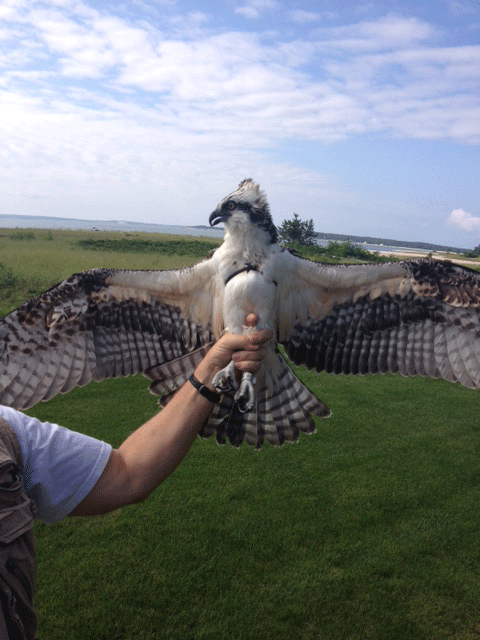 "Clyde" came in after about 40 minutes and landed right on the trap and was caught quickly. We took him down for processing, removed the trap, and left the fish in the nest. As we were outfitting him with his new transmitter, the young neighbor slipped in and snatched the porgy! Clyde weighed 1.26 kg, just under 3 lbs., which is pretty typical for a young male.
"Clyde" came in after about 40 minutes and landed right on the trap and was caught quickly. We took him down for processing, removed the trap, and left the fish in the nest. As we were outfitting him with his new transmitter, the young neighbor slipped in and snatched the porgy! Clyde weighed 1.26 kg, just under 3 lbs., which is pretty typical for a young male.
Clyde's transmitter has been lucky for us, but not for the birds who have worn it. The first bird to carry it was Tucker. Tucker was the adult male at our other "old faithful" nest on the North Fork golf course. He was hit by a bus a month or so after we tagged him.
Then we put the transmitter on Cutch, a young, non-breeding male caught while trying to pilfer our bait fish at the North Fork GC nest (I detect a theme here). Cutch made it to Colombia, only to impale himself on a submerged snag while trying to catch a fish.
Bad luck for the birds, but good luck for us--the transmitter survived the crash with a bus, and it was pretty amazing to get the transmitter back from Colombia.
Let's hope the luck changes for the birds. Third time's the charm? And we hope our luck will stay good if Clyde lives a long life with the transmitter and we don't lay our hands on it for a long time.
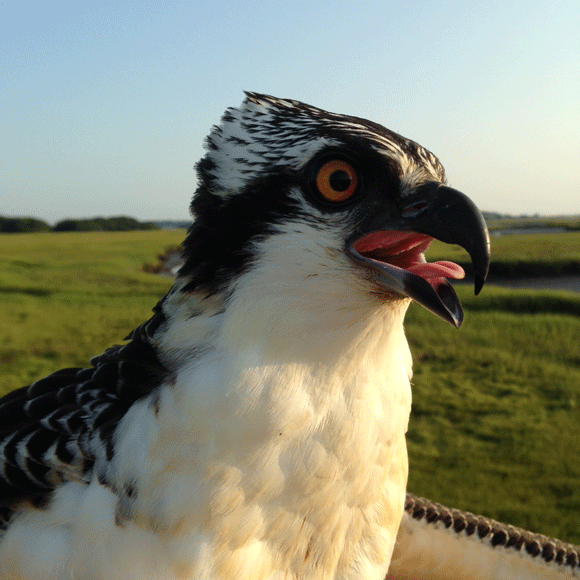 After a foiled attempt to retrap DJ on Martha's Vineyard, I headed up to northeastern Massachusetts with two transmitters to deploy on recently fledged young. (There is no reason for DJ to carry the transmitter south again. We already know he's going to the same place and will probably take a slightly different route.) One of the transmitters was recovered, rather remarkably, from Whit--a youngster tagged last year in this area. Whit was killed crossing a highway down in northern Venezuela. Thanks to the internet, we had the transmitter back in the States about 3 days after we noticed that the transmitter wasn't moving!
After a foiled attempt to retrap DJ on Martha's Vineyard, I headed up to northeastern Massachusetts with two transmitters to deploy on recently fledged young. (There is no reason for DJ to carry the transmitter south again. We already know he's going to the same place and will probably take a slightly different route.) One of the transmitters was recovered, rather remarkably, from Whit--a youngster tagged last year in this area. Whit was killed crossing a highway down in northern Venezuela. Thanks to the internet, we had the transmitter back in the States about 3 days after we noticed that the transmitter wasn't moving!
In this area, I work with Dave Rimmer of the Essex County Greenbelt Association, the organization that sponsored two transmitters this year. Greenbelt, Essex County's Land Trust, has an Osprey nest-cam on the marsh right in front of their offices. We set our trap at the nest in the marshes of the Allyn Cox Reservation by 6:10 AM. We didn't have to wait long before we caught the adult female. While we were banding her, her young came in and landed on the nest and was quickly trapped. "Flow" is a really handsome youngster--another bird with a distinctively dark head. He weighed in at a pretty typical 1.28 kg--2.8 pounds.
As an only child, he's getting lots of food. Every time I log onto the Greenbelt Osprey cam, he's chowing down on a big ol' fish.
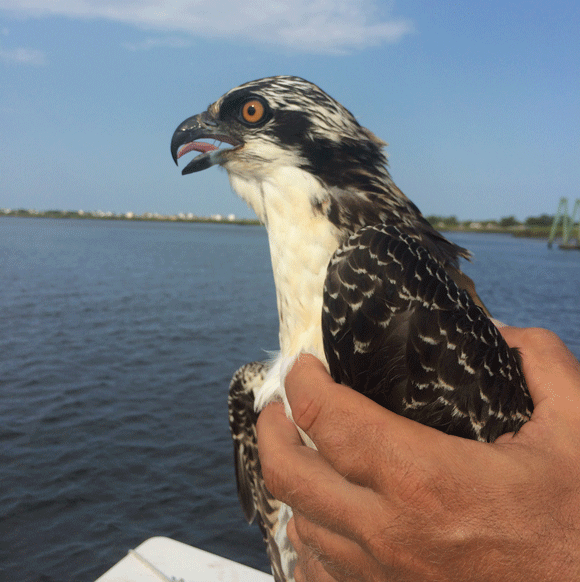 We then headed up to the mouth of the Merrimack River in Salisbury State Beach Reservation. We set our trap on a nest atop an abandoned, rickety old duck blind along Black Rock Creek, which feeds into the Merrimack not far from the Massachusetts/New Hampshire border. There were 2 young perched on the nest as we boated up the creek.
We then headed up to the mouth of the Merrimack River in Salisbury State Beach Reservation. We set our trap on a nest atop an abandoned, rickety old duck blind along Black Rock Creek, which feeds into the Merrimack not far from the Massachusetts/New Hampshire border. There were 2 young perched on the nest as we boated up the creek.
It was a long day on the marsh, including an emergency run to get ice cream at one point. After 3 hours with little or no sign of the young, we caught an adult female--probably the female from this nest. She was a monster--weighing 2.2 kg, almost 5 pounds!--the biggest Osprey I've ever held.
After a couple more hours of no action on the nest, we moved the trap to a neighboring nest pole where we'd seen birds perched the whole day we were out there.
About an hour later, with the tide dropping fast and thus little time left, we caught both young at the new nest. Thus we had a choice of which bird to tag. I noticed a slight cut on the female's wing (it was an old injury--not one suffered during trapping), and so we chose to tag her brother. "Blackie" is quite dark, which, along with the location of his nest on Black Rock Creek, gave us the idea for his name.
He is a robust young male, weighing in at 1.38 kg, which translates to just over 3 pounds. Since he was trapped, he's rarely left his nest, which fits the behavior we witnessed out on his marsh.
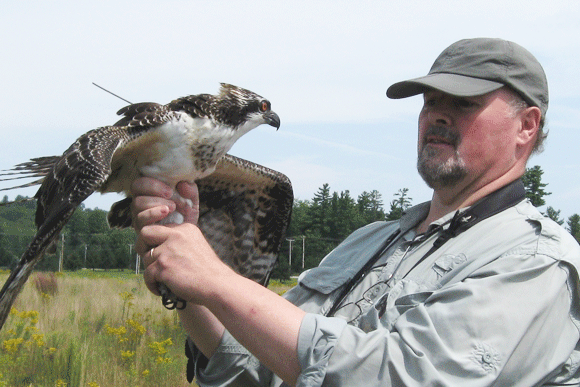 Then it was off to New Hampshire, where I teamed up with my colleague Iain MacLeod, Director of the Squam Lakes Natural Science Center, and we visited our two favorite nests in the Lakes District.
Then it was off to New Hampshire, where I teamed up with my colleague Iain MacLeod, Director of the Squam Lakes Natural Science Center, and we visited our two favorite nests in the Lakes District.
We began the day at the JJill distribution facility in Tilton at the nest where we tagged Donovan in 2013. In 2012 we tagged 2 fledglings, Jill and Chip, at this nest. Chip, you may remember, is the bird who rode ships east across the Atlantic until he was lost at sea.
We set the trap at 8:30 with both of the 2 young from the nest and their parents circling around and complaining about our invasion of their space.
It was a pretty long wait. At 11:30, a male landed on the perch above the nest and stared down at the herring we had left under the trap. About 10 minutes later, "Tilton" hopped down onto the trap and was caught.
We were hoping to trap Donovan and get his transmitter back, but he wasn't having anything to do with the nest after he saw us around it again. You know the old saying, "Fool me once, shame on you, fool me twice, shame on me," Donovan lives by that and will keep the transmitter for at least another year.
Tilton has an interesting plumage. His head is rather dark and he has quite a dark chest band for a male.
He's a bit of a pipsqueak. He weighs only 1.06 kg (about 2.3 lbs), but didn't feel thin, so I was OK with deploying the transmitter on him. He's a healthy pipsqueak.
After lunch, we returned to our old faithful nest at the Bridgewater Power plant on the banks of the Pemigewasset River. (Oh, how I love the place names in New England!) As usual, when we arrived, there were plenty of Ospreys flying around the nest. We set our trap at 1:30 and 6 minutes later (a record) had a bird on the trap.
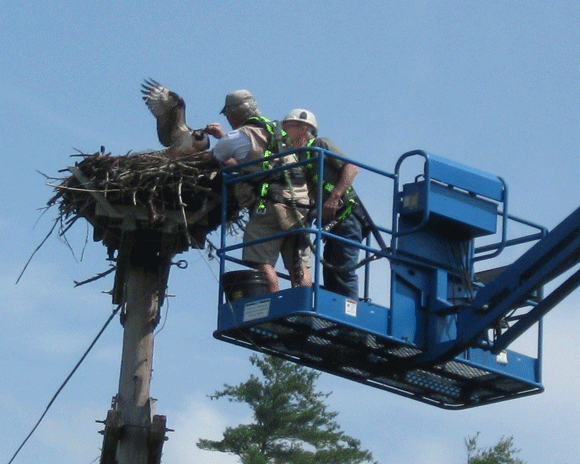 "Bridget" is the 50th juvenile Osprey I have tagged. She's most likely a small female. She weighed 1.5 kg (3.3 lbs), which would be a big male or small female. Her wing length suggests she's a female, so that's our working hypothesis.
"Bridget" is the 50th juvenile Osprey I have tagged. She's most likely a small female. She weighed 1.5 kg (3.3 lbs), which would be a big male or small female. Her wing length suggests she's a female, so that's our working hypothesis.
Bridget is the daughter of Art, who wore a radio from 2012-2013. She's also the sister of Artoo, who now is wearing the radio Art carried to Brazil and back. Artoo is down on the Amazon deep in Brazil. He'll come back in about 8 or 9 months.
She has 2 siblings. This is the second year in a row her very productive parents have fledged 3 young. In 2012 the nest blew off its pole in a violent storm. It was securely replaced, but the young couldn't be saved.
Update on tagged adults
Up in New Hampshire, Donovan is feeding two fledglings, one of which (Tilton) is now wearing a new satellite transmitter. Donovan has expanded his range a bit to the west, perhaps because the nests of his two neighbors over that way failed this year.
In the Cape Cod/Martha's Vineyard area, Belle (2010 fledgling) is now 4 years old but still doesn't have a soul--I mean nest mate. Just as she did last year, she spent the early part of the summer commuting between the Falmouth area (western Cape Cod) and the Vineyard. Now she's crossing Buzzards Bay, moving back and forth between Falmouth and Marion.
Snowy (tagged in 2011 as a fledgling on the Vineyard), spent the spring and early summer commuting between Long Pond in Falmouth and the Katama Bay area, where he was born. In early July he took a spin up towards Boston, returned to the Cape and then headed west to southwestern Connecticut--just like he did last year. This year he made a quick trip back to the Cape/Vineyard and then returned to Connecticut, where he was fishing the Stamford Reservoir. He's now down in western Long Island.
DJ, an adult male tagged last year, is turning out to be a dead-beat dad. He and his mate have one young in the nest, but it is emaciated and probably will not survive. This is the first year this young pair has had a young this old. When we tried to catch DJ, he was away from the nest for almost 7 hours and the female was doing all the hunting for the family. Maybe they'll sort it out next year.
Down in the Long Island Sound area, all sorts of interesting things are going on.
Edwin, tagged at his nest on Fishers Island last year, did not nest this year. He's made a couple of cameo appearances on Fishers Island, but has not spent any time there at all. While he's not been on Fishers, he's been pretty much all over the rest of the map around Long Island Sound. He has been as far east as Rhode Island and settled down for a bit a couple of times at the famous Gardiners Island Osprey Colony. He's recently been working the Connecticut River and has been fishing close to at least one of our birds tagged this spring at the mouth of the river.
Meanwhile on Fishers Island, Charlie, tagged this spring, and his mate raised two young at their nest at the Fishers Island recycling center. Charlie spent much of the early breeding season commuting 7-10 miles each way from Fishers to New London, where he was fishing the Thames and Niantic Rivers. For the past few weeks, he has been doing all his fishing around the western end of Fishers Island.
North-Fork Bob has still not found true love, Osprey style. He's been across the Sound to Connecticut a couple of times, but has mostly been out around his usual haunts in eastern Long Island, mostly hunting out in Peconic Bay. Recently, I've noticed that he has been visiting an big field close to his normal resting area along Deep Hole Creek. He's there most afternoons--sometimes on a pole line in the field, but more often just out somewhere in the middle of the field. This made no sense until I visited the field in early August. It turns out that there is a big irrigation thingamajiggy that moves around the field, which is clearly where he has been perching. This makes no sense, unless he's checking it out as a nest support structure for next year. Could we have the first Ospreys with a mobile home?
Across the Sound at the mouth of the Connecticut River, Gerry and Uncas raised young and did what we expected, which is to say they spent most of their time fishing for menhaden around the mouth of the river. Roger Tory, whose nest failed, surprised us by commuting pretty much daily 20 miles each way all the way up to the Salmon River, which is richly stocked with trout.
Down in the Mid-Atlantic region, Woody and his mate may or may not have raised young. We don't have reliable eyes on the ground there, so we're not sure. We do have a photo of Woody on his nest with another bird, but the lighting is bad, so it could be the female or a young. It's pretty unusual for both the male and female to be on the nest together this late in the season, so I suspect they raised at least one young.
Across the Bay on Kent Island, Chester and his mate fledged two young. He spent most of his time fishing in Eastern Bay. Crabby, our non-breeding female, after her junket east of the Bay, settled down in the Kent Island area. She liked one spot in particular south of the nest where she was trying to insinuate herself. We'll be watching that spot when she comes back next spring. Unmated females in the spring are looking for young males without a mate, or older males whose mates didn't return from their wintering grounds. Paul Spitzer's research in the Chesapeake showed that young birds can take more than 5 years to establish themselves in a breeding pair in an area with a dense Osprey population.
Further down the Bay on Tangiers Island, Nick did not breed this year. Very frustratingly we don't have any reports of what happened with Quin's nest, but at least we know that he was paired up and nested. Both Quin and Nick fished around Tangiers pretty much in the same areas they did last year.
Moving inland up the Potomac River to Washington, DC, Ron and Rodney both got back so late that their mates from last year had already paired up with new males. Ron certainly didn't breed, but Rodney may have established a late pair on one of the other pilings on the South Capital St Bridge over the Anacostia River where he and Rodney were trapped on their nests in 2013.
Meanwhile, down along the banks of the mighty Amazon, Artoo is doing fine. He spends most of his time at a small lake just south of the river, but he's now been travelling up to the river to do some fishing and exploring. He'll head north next spring sometime.
Fall Migration preview
Shorebirds have been moving south from their arctic breeding grounds for almost a month now, and warblers are beginning to show up, so our Ospreys will be moving soon. In fact, the hawk watch site at Corpus Christie, TX, has already reported the first Ospreys of the season. These will almost certainly be females--probably from failed nests--because adult females leave before males. Most females head south in mid to late August. Most males and juveniles start their migrations in the first two weeks of September.
This year I tagged 11 birds--6 adults and 5 juveniles--and we had a good return of birds previously tagged this spring, so we'll be following 22 birds as they move south starting any day now.
Here are the dates that our 11 "veterans" started south last year:
Snowy 8/14
Edwin 8/16
Woody 9/3
Rodney 9/3
Nick 9/13
Ron 9/14
Donovan 9/17
DJ 9/17
Belle 9/17
Quin 9/17
North-Fork Bob 9/24
It seems the start of fall migration is not as similar from one year to the next for an individual bird as is the start of spring migration. Birds in the fall are in no real hurry to get south, so they are more likely to wait for just the right weather--a nice strong wind out of the north--in the fall than in the spring. In the spring, they're in a rush to get home to make sure no usurper tries to take over their territory, and I don't think they get big weather systems moving in with strong winds out of the south to urge them on. So I think the northbound trip starts with some combination of hormone levels rising and an internal clock telling them it time to get back to the breeding grounds.
Keep checking the interactive maps--or check your new Animal Tracker app!--to see when our flock starts moving south. And let's hope we have as benign a hurricane season as we did last year, when we didn't lose a single bird crossing the Caribbean.
